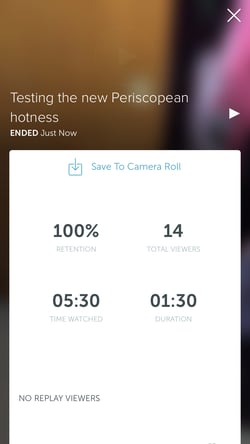
Yesterday Twitter launched Periscope, its long-rumored live-streaming mobile app service. Hot on the heels of the SXSW darling Meerkat, Periscope is designed to give the ability for anyone with the app to live stream video directly to Twitter at a push of a button.
"So what, Meerkat already does that!", you say?
Periscope's killer feature is that it also saves streams for future viewing. With Meerkat, if you can't view live streams, well, live, tough luck. With Periscope, Twitter just launched a service that truly puts a full-blown live broadcasting platform - for free - in every iPhone holder's hands. True, global adoption of live streaming has seen its hiccups (remember Viddy, Livestream, and Justin.tv?)
But now it's different.
I believe as a society we've both culturally and technologically reached the point where live streaming makes sense while being accessible to a huge user base. Smartphones are the norm; their ubiquitous cameras are uniformly excellent, certainly good enough to make most live streams watchable. In most of the world data plans can handle live streaming without breaking the bank. Culturally, the "selfie generation" has become very comfortable with sharing the minutiae everything they do -- now they're getting comfortable doing that with video.
So why should you care?
1. It's Free, Interactive, and part of Twitter
Periscope isn't built on Twitter like Meerkat was. Like Vine, it's part of the Twitter family. It's is a big difference.
By now, everyone's probably heard of the fracas (forgive the Top Gear reference) caused by Twitter as it cut Meerkat's access to Twitter's social graph off days before SXSW. This makes it much harder for Meerkat users to be notified when their friends broadcast or sign up for the service. Meerkat's now going to have to work a whole lot harder to spread its app organically. I get it, everyone these days tries to be the 'it' thing at SXSW and Twitter wasn't happy with an upstart stealing its thunder. And becoming a Twitter power user is getting harder as the network grows.
One of the coolest features Periscope offers is lightweight interactivity in the form of hearts that can be sent by viewers to presenters, live, and in real-time. Meerkat allowed, as does Periscope, viewers to comment on live streams, sure, but live streaming doesn't usually allow for people to stop what they are doing to answer a user comment, at least without a second screen or detracting from the stream. In Periscope, hearts on popular streams effervescently fill the presenter's screen if they're doing a good job. It's engaging for both presenter and viewer and doesn't detract from the live content. And it's incredibly easy to send a heart: viewers simply have to tap the screen. More taps, more hearts.

Oh, and of course there's a "most loved" list inside the app. Cue the masses of both people trying to game that system and internet celebs begging for hearts in 3... 2... . Gotta get that positive, realtime, Internet cred!
Every time you stream you're given metrics related to your effort, including:
- Retention - % of viewers that hung on till the bitter end
- Total Viewers
- Time Watched - total amount of time watched by all viewers as a whole
- Duration
- Replay Viewers - list of people who've watched your recorded stream
- Live Viewers - list of people who watched it live

Note that Periscope does not integrate with or launch from Twitter, at least not yet. It's a separate app and Twitter has made the decision to keep it that way due to the different nature of engagement on each platform. But Periscope gets access to Twitter's funds and also its technical support organization, making it a much better choice for brands getting their feet wet in the live streaming world.
2. You can replay and share content
This is Periscope's undeniably killer feature and the one that should terrify Meerkat.
As soon as a stream is completed it's immediately saved and uploaded for replaying. This is critical. There are multiple times I've used Meerkat for something, then stopped, realizing that I can't replay that content later so abandoned it. Both Meerkat and Periscope allow you to save your streams to your Camera Roll, but only Periscope saves streams automatically allowing you to replay them.
Another great feature: Periscope offers viewers the ability to share a live stream easily by swiping right on the screen and clicking, "Share Broadcast." This will likely really help drive its adoption.
By far, however, replayability is the big differentiator between these two apps.
3. It will change the way video content is created
Periscope and Meerkat notifications can be overwhelming and at times downright annoying depending upon the number of people you follow. You'll likely change the default notification settings quickly.
This wouldn't be a problem if the content they were announcing was routinely good; however, in most cases I've been met with watching random people make breakfast, streams of people streaming (Meerkatting Meerkatters, a favorite), and other random content. Sure there were some high points but in general the quality has been low so far in my experience. Meerkat reinforced this because of its transient nature. You could post whatever you wanted, no harm, no foul. It wasn't saved anyway.
Periscope changes that.
My opinion of what is poor content may not be the same as yours. Video is hard, short video is harder, and live video used to be the domain of the professional. People will get better with experience.
In general, content will improve over time (and quickly) because crappy content will be viewable after the fact, unless deleted by the presenter. With the ability to save streams serious broadcasters, journalists, and others will start to broadcast regularly. But even if content doesn't improve I still think these apps will see high adoption rates. I have several pseudo-voyeuristic friends who are addicted to Meerkat's streams and the short glimpses into others' lives they offer. Perhaps this is where we're heading and that's not a bad thing.
This is also great for companies, because Periscope will offer a lightweight, powerful tool making live streaming easily accessible without the normally huge spend such a production entails. And as audiences become used to live streaming the need to make polished, professional-looking videos will likely decrease. Just participating and engaging with audiences may make closing that final mile of customer engagement possible.
Conclusion
For companies the low cost and ability to save streams are a huge win. Live streaming has always been an expensive proposition. Not anymore. Brands can easily use Periscope to record everything they do, from internal meetings, presentations, events, and whatever else they desire. The rise of live streaming will likely also result in revamped privacy and mobile usage policies within many companies, in regulated industries or not.
It will be interesting to see how large conferences and other events that charge for their content will be able to stem the use of Periscope, especially since WiFi performance -- long the bane of the big conference attendee -- has improved dramatically over the years.
As people become better broadcasters the content the produce will improve. And the power of having a TV station in your pocket will definitely change the way news and live events will be shared around the world.
Tags:
Social Media NewsMar 27, 2015


